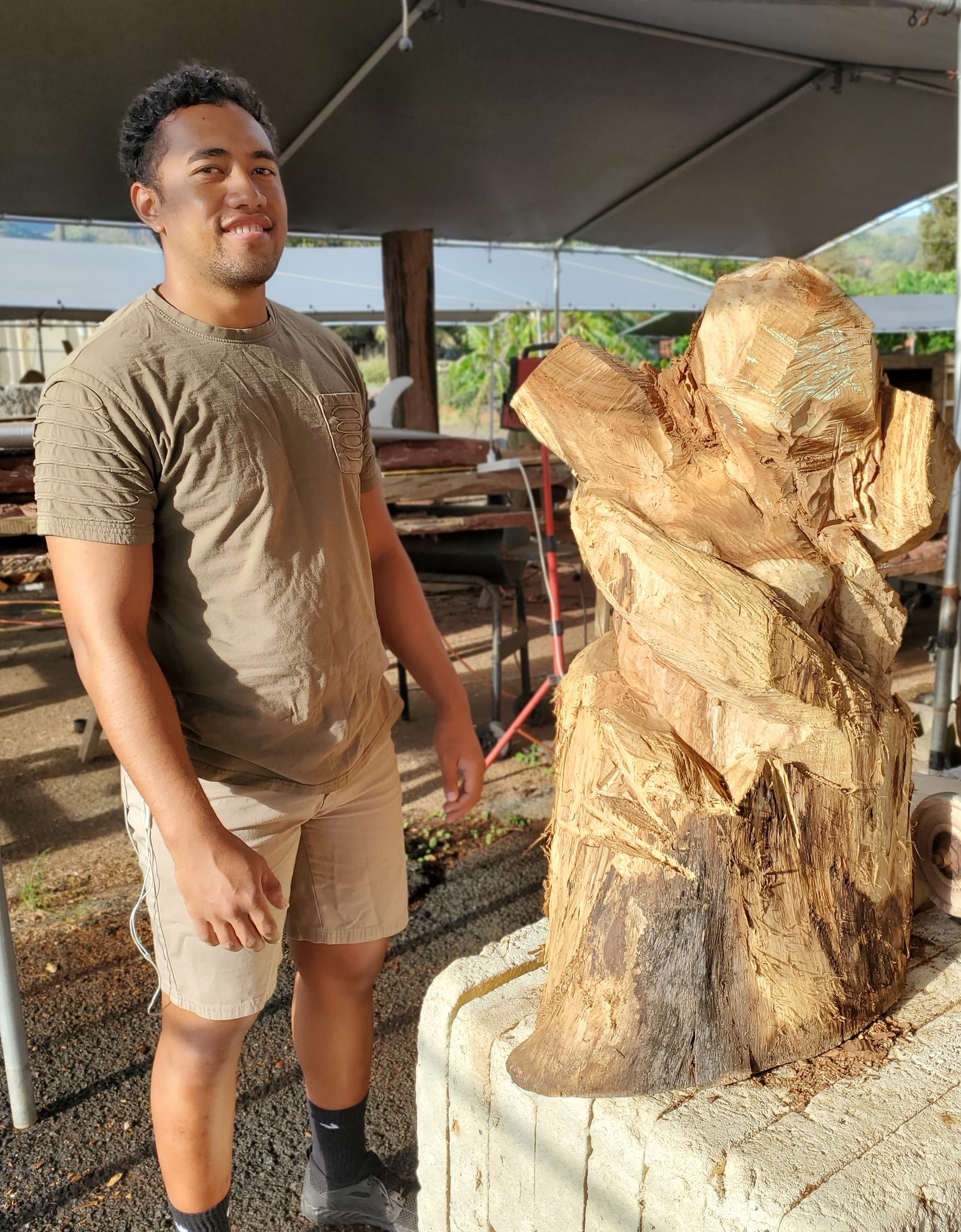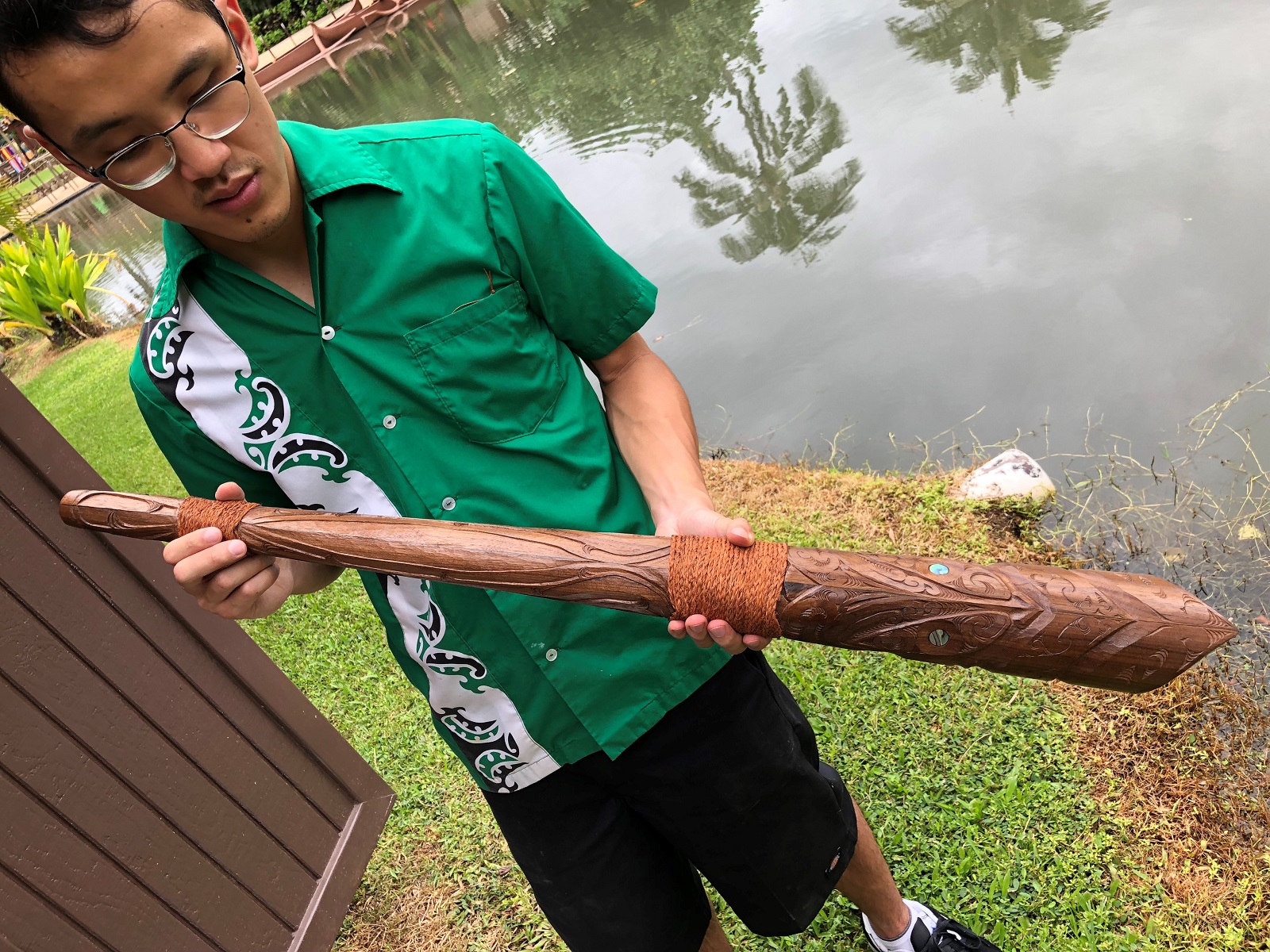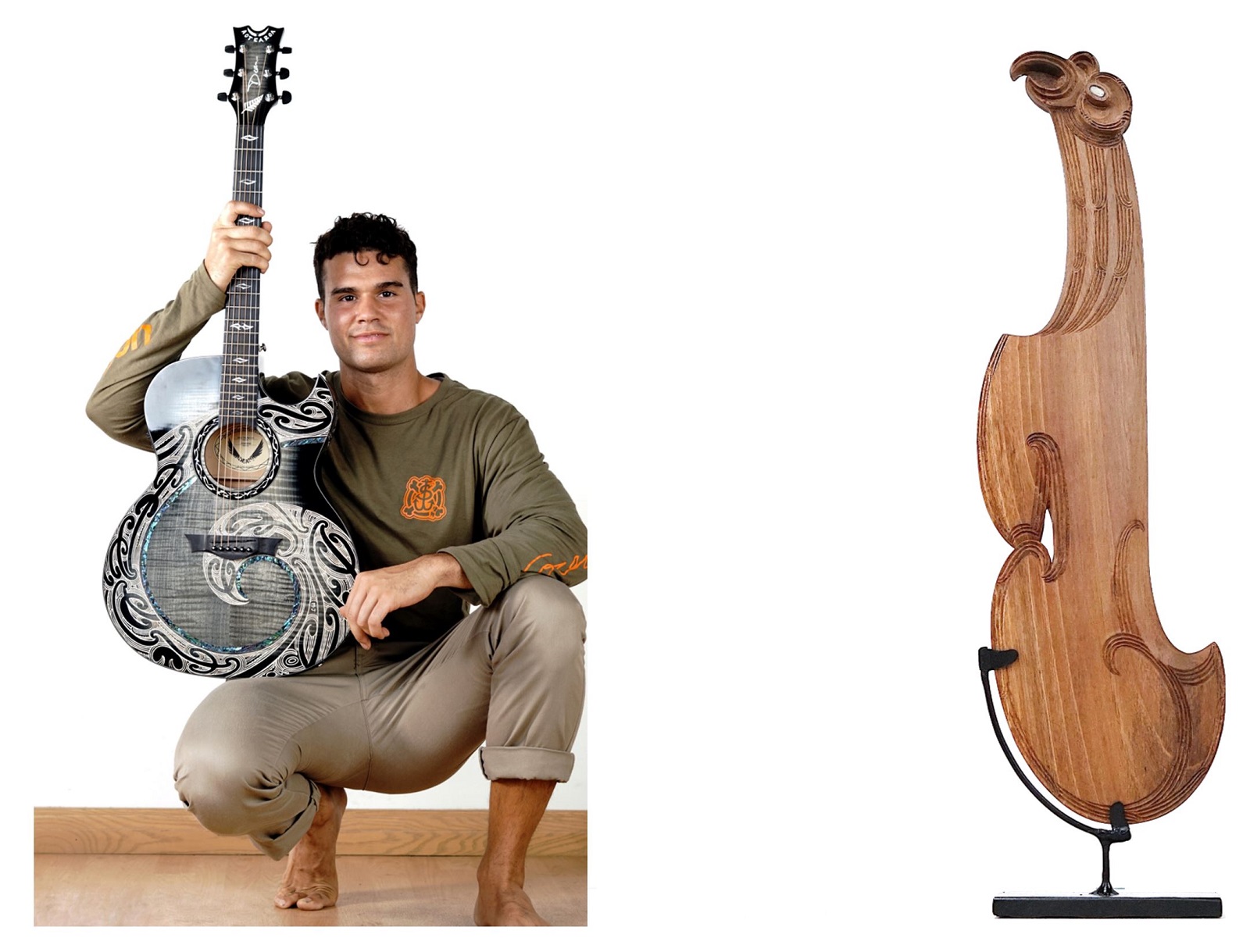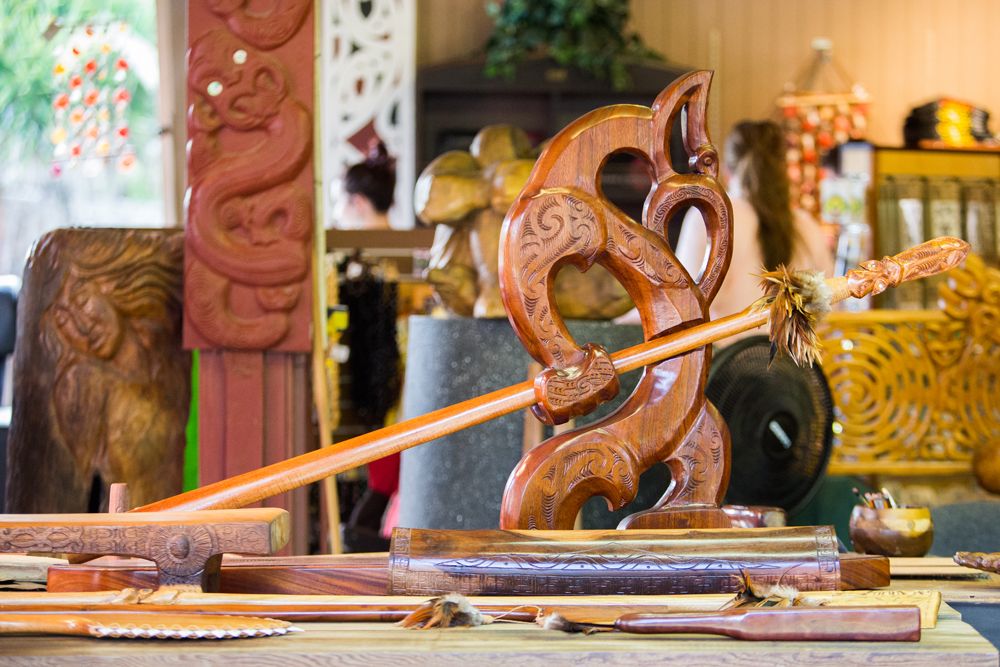Preserving the art of Polynesia
In Part 3 of our series on the Carvers of the Polynesian Cultural Center we meet the student carvers – three young men from diverse backgrounds who feel blessed to be members of the team.
The senior carvers are dedicated to making sure that all three apprentices learn not only how to carve, but how to live the life of a carver. They need to be dedicated to the years of hard work and sacrifice that will be required of them, humble enough to realize the weight upon them to represent and protect the Polynesian culture, and confident enough to stretch far beyond what they think they are capable of.
Clearly this is a rare opportunity to step out of the formal classroom and into the guidance of masters of their field.
——————————————————————————————————————————————
Sione Halahingano – Making his family proud

Sione Halahingano from Tonga
Sione Halahingano is a soft-spoken man from Tonga. As we sat down, it became clear that interviews were way out of his comfort zone. Luckily, I had sent all of the student carvers the questions a few days before, so he wasn’t caught too much of guard. We started with the basics.
Sione is seeking his degree in Graphic Design and plans on graduating in the Winter of 2021. His wife Sade, who is of Samoan descent, is from Australia. They have been married for about a year.
His dad works in construction, which includes cabinetry. Sione had always found it fascinating to watch his father build such strong and sturdy cabinets. It instilled in him the desire to create with his hands. His dad also thought that Sione’s interest in woodworking may be genetic as his grandfather carved small canoes.
Another form of art
I asked him how he enjoys such a creative job. “Carving is just another form of art,” he replied thoughtfully. “When I first applied, I thought it would be hard, but I enjoy it very much. It has already influenced my style of sculpture. My perspective has also changed. I was surprised at how different the two approaches are. In traditional sculpting, you are adding to your work but in wood carving you are taking material off. You have to rethink what you’re doing and how you are doing it.”
He has found that Monkey Pod is his favorite wood to work with. I asked him what the hardest wood to work with was. “Hmmmmmm, what do you think, guys”, he asked the other students? “Ironwood”, they both chimed in. “Oh yes, that’s true. It’s like carving concrete,” he chuckled.
Sione doesn’t have a favorite project – instead giving the typical artistic reply of “whatever I’m working on at the time becomes my favorite project.”
Creating a legend
He then offered to show me his current piece. “This is a Tongan representation of the Legend of Hina and the Eel, which tells the story about the creation of the coconut tree. “Have you heard about that one,” he asked me? I was pleased to be able to say yes. Traditionally, the legend includes the fact that Hina is very beautiful. The eel becomes infatuated with her and turns into her lifelong companion. When he is about to die, he tells her to plant him in the ground, head first. From that grows the first coconut tree, meant as a gift to her and her people. The story is popular throughout Polynesia, with minor adjustments here and there.
“I’m making this from Monkey Pod wood”, “Sione explains.” You can see her starting to form here and the eel is wrapped across her waist.”
The Tongans are such kind and honorable people. You can tell that Sione comes in everyday ready to work hard, absorb everything and make his family proud. I know that the senior carvers recognize his efforts and are very pleased to have him as part of their team. Their reward is knowing how much this experience will help him to build a better future for his family.
Ho Yan Ching (Samuel) – I have learned so much

Ho Yan Ching from Hong Kong
Samuel was next to be interviewed. He has a lot figured out for his age. He seems fairly level headed, and able to meld his dreams to fit with his circumstances. He is from Hong Kong and is majoring in Art, with a focus in painting, while minoring in Education. Samuel has been working with the carvers for 1.5 years.
Samuel and his wife Jane, from mainland China, have been married 4 months. He will be graduating in the Winter of 2022.
Samuel has already had some experience in oil painting before arriving at BYUH. He found it very interesting, He decided to choose that course of study along with Art Education because he likes the concept of sharing his skills with others.
A unique opportunity
“Working in the Carving Department has been pretty unique,” Samuel shares. “The staff allows the students to be a part of the process and teaches us to respect our guests and their appreciation in what we create. When I have an opportunity to present to our visitors, I remember that I’m not there to discuss my project. I don’t talk about myself at all. I have the opportunity to share something very important, the Polynesian culture, and how art represents life to them. “
“I enjoy all styles of carving but when I first started, I was given the opportunity to learn the meaning behind many of the Polynesian designs. This became especially important when I started carving weapons. I could know what design was appropriate for each item. I actually enjoy carving smaller pieces. When a guest takes a weapon in their hands, they can feel it. They can wrap their hands around it and feel its weight. This intimacy helps them to connect with what they are seeing.”
Carving as a career boost
“Carving is really helpful in many career aspects. It assists you in concept planning, helps you visualize what you want to create, and teaches you how to work through a complicated project from start to finish.”
“In the future, I am definitely interested in continuing to paint landscapes. I love how creating atmosphere can show so much more than figure art. It has more freedom. You can draw what you like, change it around as you like. Figure art is more exact, more specific.”
However, I am also impressed with 3D modeling for movies. It is a growing industry, and will only become bigger. “
Applying lessons learned
“I will also keep carving, especially in wood. I think that in Hong Kong I will create smaller scale pieces. I always wanted to try carving, but I had no idea the scale of work and the depth of the process until this job. I have learned so much.”
By giving the opportunity to stretch and experiment with new art forms, Samuel has learned much from other cultures. The skill is in taking those lessons and applying them into his culture and his lifestyle. I think it is impressive how down to earth he is. He knows what will sell in Hong Kong. He knows that his future must include sharing his knowledge with other to be fulfilling. His experience at the Polynesian Cultural Center has helped him to expand both his skills and his connection to the world, and you can tell that he hasn’t wasted that opportunity.
Samuel (Hamiora) Mangakahia – A clearly established vision

Samuel Mangakahia – Australia holds one of his carved guitars (l); a Maori war club – called a wahaika (r) that Sam created in the Carver’s Workshop
I can tell that Samuel (Hamiora) Mangakahia has contemplated not just what his future could look like, but what it should look like. He is clearly interested in quality rather than quantity. Some may even call him a dreamer, but actually, he is a truth seeker.
Sam, from Brisbane, Australia, has been at BYUH and the Polynesian Cultural Center for two years. He is majoring in Graphic Design with a minor in Entrepreneurship and will be graduating this fall. He is single and focusing on the question everyone must be asking him, “what comes next?” He might be struggling with a few details, but his vision is clearly established.
The life I plan to live
After hearing his answers to the typical ‘getting to know you’ question, I started by asking “Why are you combining design and entrepreneurship?.”
“Well”, he explained, “without an entreprenual focus, it’s hard to live a life that a can sustain you. I don’t want to trade my time for money. In that world, the better you are, the busier you get. The busier you get, the more money you make. With that type of success, you soon have to deal with more expenses. To maintain your success, you then start chasing the money. At the end of the day it becomes more of a task than an enjoyment. This is not the life I plan to live.”
“I completed an internship in New Zealand, working with Rangi Kipa. He taught different designs and methods. It is easy to recognize his work. He has a very distinct style, and I really connect to it.”
Simple yet complex
“Maori carving is my favorite art form. Yes, because It is my heritage. But I also find that it involves the most design principles. It is a simple art form, yet it is also very complex. There are intricate patterns but the form tends to be very simple, like the weapons, for instance. Many people focus on the details, but to me it’s the shape that conveys it’s true character.”
“My favorite piece that I have made is a Maori war club – called a wahaika (pictured above). I also enjoy carving guitars and ukuleles. I have been working on a number of pieces for specific musicians. I try to help each of them share their story; to reflect their history and the things important to them.”
Sometimes people look suspiciously at young adults with dreams – assuming that it’s just a phase. I can’t imagine that will happen with Sam. I think he knows exactly what will make him happy and what would make him miserable. It’s obvious that the senior carvers at the Polynesian Cultural Center have helped him to examine and honor his unique skills and opportunities. It’s going to be exciting to see where his path takes him.
More to come
We hope that you are enjoying our series about the Carvers of the Polynesian Cultural Center. Stay tuned for the next post, which will show you what goes into making the various canoes used throughout the Center.
The Carvers of the Polynesian Center series
#1 – An abundance of blessings
#2 – Fulfilling the Center’s Mission
#3 – Preserving the art of Polynesia
#4 – Carving Polynesian Canoes
#5 – To be announced!


I just want to say that I was able to fly to the big island & go to the Polynesian Cultural Center. I was able to drink from the coconut tree that a young guy had climbed up then they shred the coconut and we all had a very tasty drink. I simply loved the island and all the people.
I had many young boys & girls who were getting into hard time crimes. And they found out that when one of the Polynesian staff told the kids to do something, that meant business!!
The island was so very beautiful with all kinds of flowers growing every where. I had to smell each one. I hope to go there again some day. The best part of it was the Polynesian Cultural Center and the crystal clear ocean that made you think the water was only a couple yards deep!!! Great to see that these young men are creating so many things that will help them in their lives. I will always treasure my time with the young men & women at my work,
Thank you for creating this article.